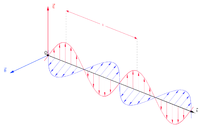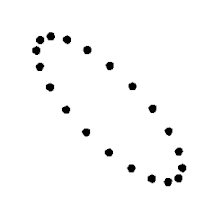From Wikipedia, the free encyclopedia
In physics, a wave is disturbance or oscillation (of a physical quantity), that travels through matter or space, accompanied by a transfer of energy. Wave motion transfers energy from one point to another, often with no permanent displacement of the particles of the medium—that is, with little or no associated mass transport. They consist, instead, of oscillations or vibrations around almost fixed locations. Waves are described by a wave equation which sets out how the disturbance proceeds over time. The mathematical form of this equation varies depending on the type of wave.
There are two main types of waves. Mechanical waves propagate through a medium, and the substance of this medium is deformed. The deformation reverses itself owing to restoring forces resulting from its deformation. For example, sound waves propagate via air molecules colliding with their neighbors. When air molecules collide, they also bounce away from each other (a restoring force). This keeps the molecules from continuing to travel in the direction of the wave.
The second main type of wave, electromagnetic waves, do not require a medium. Instead, they consist of periodic oscillations of electrical and magnetic fields generated by charged particles, and can therefore travel through a vacuum. These types of waves vary in wavelength, and include radio waves, microwaves, infrared radiation, visible light, ultraviolet radiation, X-rays, and gamma rays.
Further, the behavior of particles in quantum mechanics are described by waves. In addition, gravitational waves also travel through space, which are a result of a vibration or movement in gravitational fields.
A wave can be transverse or longitudinal depending on the direction of its oscillation. Transverse waves occur when a disturbance creates oscillations that are perpendicular (at right angles) to the propagation (the direction of energy transfer). Longitudinal waves occur when the oscillations are parallel to the direction of propagation. While mechanical waves can be both transverse and longitudinal, all electromagnetic waves are transverse in free space.
General features
A single, all-encompassing definition for the term wave is not straightforward. A vibration can be defined as a back-and-forth motion around a reference value. However, a vibration is not necessarily a wave. An attempt to define the necessary and sufficient characteristics that qualify a phenomenon to be called a wave results in a fuzzy border line.The term wave is often intuitively understood as referring to a transport of spatial disturbances that are generally not accompanied by a motion of the medium occupying this space as a whole. In a wave, the energy of a vibration is moving away from the source in the form of a disturbance within the surrounding medium (Hall 1980, p. 8). However, this notion is problematic for a standing wave (for example, a wave on a string), where energy is moving in both directions equally, or for electromagnetic (e.g., light) waves in a vacuum, where the concept of medium does not apply and interaction with a target is the key to wave detection and practical applications. There are water waves on the ocean surface; gamma waves and light waves emitted by the Sun; microwaves used in microwave ovens and in radar equipment; radio waves broadcast by radio stations; and sound waves generated by radio receivers, telephone handsets and living creatures (as voices), to mention only a few wave phenomena.
It may appear that the description of waves is closely related to their physical origin for each specific instance of a wave process. For example, acoustics is distinguished from optics in that sound waves are related to a mechanical rather than an electromagnetic wave transfer caused by vibration. Concepts such as mass, momentum, inertia, or elasticity, become therefore crucial in describing acoustic (as distinct from optic) wave processes. This difference in origin introduces certain wave characteristics particular to the properties of the medium involved. For example, in the case of air: vortices, radiation pressure, shock waves etc.; in the case of solids: Rayleigh waves, dispersion; and so on.
Other properties, however, although usually described in terms of origin, may be generalized to all waves. For such reasons, wave theory represents a particular branch of physics that is concerned with the properties of wave processes independently of their physical origin.[1] For example, based on the mechanical origin of acoustic waves, a moving disturbance in space–time can exist if and only if the medium involved is neither infinitely stiff nor infinitely pliable. If all the parts making up a medium were rigidly bound, then they would all vibrate as one, with no delay in the transmission of the vibration and therefore no wave motion. On the other hand, if all the parts were independent, then there would not be any transmission of the vibration and again, no wave motion. Although the above statements are meaningless in the case of waves that do not require a medium, they reveal a characteristic that is relevant to all waves regardless of origin: within a wave, the phase of a vibration (that is, its position within the vibration cycle) is different for adjacent points in space because the vibration reaches these points at different times.
Mathematical description of one-dimensional waves
Wave equation
Consider a traveling transverse wave (which may be a pulse) on a string (the medium). Consider the string to have a single spatial dimension. Consider this wave as traveling- in the
 direction in space. E.g., let the positive
direction in space. E.g., let the positive  direction be to the right, and the negative
direction be to the right, and the negative  direction be to the left.
direction be to the left. - with constant amplitude

- with constant velocity
 , where
, where  is
is
- independent of wavelength (no dispersion)
- independent of amplitude (linear media, not nonlinear).[2]
- with constant waveform, or shape
 (waveform
(waveform  traveling to the right)
traveling to the right) (waveform
(waveform  traveling to the left)
traveling to the left)
 and
and  traveling through the medium in opposite directions. A generalized representation of this wave can be obtained[4] as the partial differential equation
traveling through the medium in opposite directions. A generalized representation of this wave can be obtained[4] as the partial differential equationWave forms
The form or shape of F in d'Alembert's formula involves the argument x − vt. Constant values of this argument correspond to constant values of F, and these constant values occur if x increases at the same rate that vt increases. That is, the wave shaped like the function F will move in the positive x-direction at velocity v (and G will propagate at the same speed in the negative x-direction).[6]
In the case of a periodic function F with period λ, that is, F(x + λ − vt) = F(x − vt), the periodicity of F in space means that a snapshot of the wave at a given time t finds the wave varying periodically in space with period λ (the wavelength of the wave). In a similar fashion, this periodicity of F implies a periodicity in time as well: F(x − v(t + T)) = F(x − vt) provided vT = λ, so an observation of the wave at a fixed location x finds the wave undulating periodically in time with period T = λ/v.[7]
Amplitude and modulation
 is the amplitude envelope of the wave,
is the amplitude envelope of the wave,  is the wavenumber and
is the wavenumber and  is the phase. If the group velocity
is the phase. If the group velocity  (see below) is wavelength-independent, this equation can be simplified as:[11]
(see below) is wavelength-independent, this equation can be simplified as:[11]Phase velocity and group velocity
Frequency dispersion in groups of gravity waves on the surface of deep water. The red dot moves with the phase velocity, and the green dots propagate with the group velocity.
There are two velocities that are associated with waves, the phase velocity and the group velocity. To understand them, one must consider several types of waveform. For simplification, examination is restricted to one dimension.
The most basic wave (a form of plane wave) may be expressed in the form:
 , makes clear that this expression describes a vibration of wavelength
, makes clear that this expression describes a vibration of wavelength  traveling in the x-direction with a constant phase velocity
traveling in the x-direction with a constant phase velocity  .[13]
.[13]The other type of wave to be considered is one with localized structure described by an envelope, which may be expressed mathematically as, for example:
The exponential function inside the integral for ψ oscillates rapidly with its argument, say φ(k1), and where it varies rapidly, the exponentials cancel each other out, interfere destructively, contributing little to ψ.[13] However, an exception occurs at the location where the argument φ of the exponential varies slowly. (This observation is the basis for the method of stationary phase for evaluation of such integrals.[15]) The condition for φ to vary slowly is that its rate of change with k1 be small; this rate of variation is:[13]
In other words, the velocity of the constituent waves of the wave packet travel at a rate that varies with their wavelength, so some move faster than others, and they cannot maintain the same interference pattern as the wave propagates.
Sinusoidal waves
Mathematically, the most basic wave is the (spatially) one-dimensional sine wave (or harmonic wave or sinusoid) with an amplitude
 described by the equation:
described by the equation: is the maximum amplitude of the wave, maximum distance from the highest point of the disturbance in the medium (the crest) to the equilibrium point during one wave cycle. In the illustration to the right, this is the maximum vertical distance between the baseline and the wave.
is the maximum amplitude of the wave, maximum distance from the highest point of the disturbance in the medium (the crest) to the equilibrium point during one wave cycle. In the illustration to the right, this is the maximum vertical distance between the baseline and the wave. is the space coordinate
is the space coordinate is the time coordinate
is the time coordinate is the wavenumber
is the wavenumber is the angular frequency
is the angular frequency is the phase constant.
is the phase constant.
The wavelength
 is the distance between two sequential crests or troughs (or other equivalent points), generally is measured in meters. A wavenumber
is the distance between two sequential crests or troughs (or other equivalent points), generally is measured in meters. A wavenumber  , the spatial frequency of the wave in radians per unit distance (typically per meter), can be associated with the wavelength by the relation
, the spatial frequency of the wave in radians per unit distance (typically per meter), can be associated with the wavelength by the relation is the time for one complete cycle of an oscillation of a wave. The frequency
is the time for one complete cycle of an oscillation of a wave. The frequency  is the number of periods per unit time (per second) and is typically measured in hertz. These are related by:
is the number of periods per unit time (per second) and is typically measured in hertz. These are related by:The angular frequency
 represents the frequency in radians per second. It is related to the frequency or period by
represents the frequency in radians per second. It is related to the frequency or period by of a sinusoidal waveform traveling at constant speed
of a sinusoidal waveform traveling at constant speed  is given by:[17]
is given by:[17] is called the phase speed (magnitude of the phase velocity) of the wave and
is called the phase speed (magnitude of the phase velocity) of the wave and  is the wave's frequency.
is the wave's frequency.Wavelength can be a useful concept even if the wave is not periodic in space. For example, in an ocean wave approaching shore, the incoming wave undulates with a varying local wavelength that depends in part on the depth of the sea floor compared to the wave height. The analysis of the wave can be based upon comparison of the local wavelength with the local water depth.[18]
Although arbitrary wave shapes will propagate unchanged in lossless linear time-invariant systems, in the presence of dispersion the sine wave is the unique shape that will propagate unchanged but for phase and amplitude, making it easy to analyze.[19] Due to the Kramers–Kronig relations, a linear medium with dispersion also exhibits loss, so the sine wave propagating in a dispersive medium is attenuated in certain frequency ranges that depend upon the medium.[20] The sine function is periodic, so the sine wave or sinusoid has a wavelength in space and a period in time.[21][22]
The sinusoid is defined for all times and distances, whereas in physical situations we usually deal with waves that exist for a limited span in space and duration in time. Fortunately, an arbitrary wave shape can be decomposed into an infinite set of sinusoidal waves by the use of Fourier analysis. As a result, the simple case of a single sinusoidal wave can be applied to more general cases.[23][24] In particular, many media are linear, or nearly so, so the calculation of arbitrary wave behavior can be found by adding up responses to individual sinusoidal waves using the superposition principle to find the solution for a general waveform.[25] When a medium is nonlinear, the response to complex waves cannot be determined from a sine-wave decomposition.
Plane waves
Standing waves
A standing wave, also known as a stationary wave, is a wave that remains in a constant position. This phenomenon can occur because the medium is moving in the opposite direction to the wave, or it can arise in a stationary medium as a result of interference between two waves traveling in opposite directions.
The sum of two counter-propagating waves (of equal amplitude and frequency) creates a standing wave. Standing waves commonly arise when a boundary blocks further propagation of the wave, thus causing wave reflection, and therefore introducing a counter-propagating wave. For example when a violin string is displaced, transverse waves propagate out to where the string is held in place at the bridge and the nut, where the waves are reflected back. At the bridge and nut, the two opposed waves are in antiphase and cancel each other, producing a node. Halfway between two nodes there is an antinode, where the two counter-propagating waves enhance each other maximally. There is no net propagation of energy over time.
-
One-dimensional standing waves; the fundamental mode and the first 5 overtones.
-
A two-dimensional standing wave on a disk; this is the fundamental mode.
-
A standing wave on a disk with two nodal lines crossing at the center; this is an overtone.
Physical properties
Transmission and media
Waves normally move in a straight line (i.e. rectilinearly) through a transmission medium. Such media can be classified into one or more of the following categories:- A bounded medium if it is finite in extent, otherwise an unbounded medium
- A linear medium if the amplitudes of different waves at any particular point in the medium can be added
- A uniform medium or homogeneous medium if its physical properties are unchanged at different locations in space
- An anisotropic medium if one or more of its physical properties differ in one or more directions
- An isotropic medium if its physical properties are the same in all directions
Absorption
Absorption of waves mean, if a kind of wave strikes a matter, it will be absorbed by the matter. When a wave with that same natural frequency impinges upon an atom, then the electrons of that atom will be set into vibrational motion. If a wave of a given frequency strikes a material with electrons having the same vibrational frequencies, then those electrons will absorb the energy of the wave and transform it into vibrational motion.Reflection
When a wave strikes a reflective surface, it changes direction, such that the angle made by the incident wave and line normal to the surface equals the angle made by the reflected wave and the same normal line.Interference
Waves that encounter each other combine through superposition to create a new wave called an interference pattern. Important interference patterns occur for waves that are in phase.Refraction
Refraction is the phenomenon of a wave changing its speed. Mathematically, this means that the size of the phase velocity changes. Typically, refraction occurs when a wave passes from one medium into another. The amount by which a wave is refracted by a material is given by the refractive index of the material. The directions of incidence and refraction are related to the refractive indices of the two materials by Snell's law.
Diffraction
A wave exhibits diffraction when it encounters an obstacle that bends the wave or when it spreads after emerging from an opening. Diffraction effects are more pronounced when the size of the obstacle or opening is comparable to the wavelength of the wave.Polarization
A wave is polarized if it oscillates in one direction or plane. A wave can be polarized by the use of a polarizing filter. The polarization of a transverse wave describes the direction of oscillation in the plane perpendicular to the direction of travel.Longitudinal waves such as sound waves do not exhibit polarization. For these waves the direction of oscillation is along the direction of travel.
Dispersion
A wave undergoes dispersion when either the phase velocity or the group velocity depends on the wave frequency. Dispersion is most easily seen by letting white light pass through a prism, the result of which is to produce the spectrum of colours of the rainbow. Isaac Newton performed experiments with light and prisms, presenting his findings in the Opticks (1704) that white light consists of several colours and that these colours cannot be decomposed any further.[26]Mechanical waves
Waves on strings
The speed of a transverse wave traveling along a vibrating string ( v ) is directly proportional to the square root of the tension of the string ( T ) over the linear mass density ( μ ):Acoustic waves
Acoustic or sound waves travel at speed given byWater waves
- Ripples on the surface of a pond are actually a combination of transverse and longitudinal waves; therefore, the points on the surface follow orbital paths.
- Sound—a mechanical wave that propagates through gases, liquids, solids and plasmas;
- Inertial waves, which occur in rotating fluids and are restored by the Coriolis effect;
- Ocean surface waves, which are perturbations that propagate through water.
Seismic waves
Shock waves
Other
- Waves of traffic, that is, propagation of different densities of motor vehicles, and so forth, which can be modeled as kinematic waves[27]
- Metachronal wave refers to the appearance of a traveling wave produced by coordinated sequential actions.
- It is worth noting that the mass-energy equivalence equation can be solved for this form:
 .
.
Electromagnetic waves
An electromagnetic wave consists of two waves that are oscillations of the electric and magnetic fields. An electromagnetic wave travels in a direction that is at right angles to the oscillation direction of both fields. In the 19th century, James Clerk Maxwell showed that, in vacuum, the electric and magnetic fields satisfy the wave equation both with speed equal to that of the speed of light. From this emerged the idea that light is an electromagnetic wave. Electromagnetic waves can have different frequencies (and thus wavelengths), giving rise to various types of radiation such as radio waves, microwaves, infrared, visible light, ultraviolet and X-rays.Quantum mechanical waves
The Schrödinger equation describes the wave-like behavior of particles in quantum mechanics. Solutions of this equation are wave functions which can be used to describe the probability density of a particle.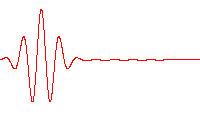
A propagating wave packet; in general, the envelope of the wave packet moves at a different speed than the constituent waves.[28]
de Broglie waves
Louis de Broglie postulated that all particles with momentum have a wavelengthA wave representing such a particle traveling in the k-direction is expressed by the wave function as follows:
In representing the wave function of a localized particle, the wave packet is often taken to have a Gaussian shape and is called a Gaussian wave packet.[30] Gaussian wave packets also are used to analyze water waves.[31]
For example, a Gaussian wavefunction ψ might take the form:[32]
The parameter σ decides the spatial spread of the Gaussian along the x-axis, while the Fourier transform shows a spread in wave vector k determined by 1/σ. That is, the smaller the extent in space, the larger the extent in k, and hence in λ = 2π/k.


 direction in space. E.g., let the positive
direction in space. E.g., let the positive  (waveform
(waveform  (waveform
(waveform 

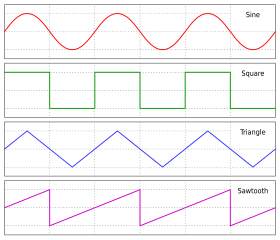
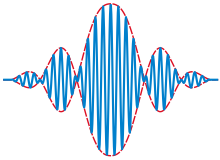












 is the maximum
is the maximum  is the time coordinate
is the time coordinate



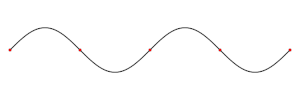






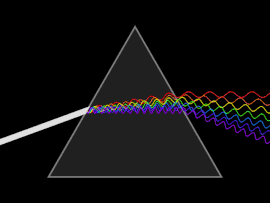



 .
.